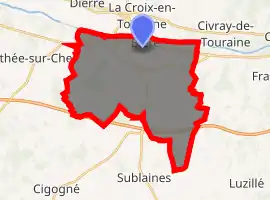Bléré
Bléré is a commune in the Indre-et-Loire department in central France.
Bléré | |
|---|---|
..jpg.webp) The Chapel of Jehan de Saignés, in Bléré | |
.svg.png.webp) Coat of arms | |
Location of Bléré 
| |
 Bléré  Bléré | |
| Coordinates: 47°19′33″N 0°59′26″E | |
| Country | France |
| Region | Centre-Val de Loire |
| Department | Indre-et-Loire |
| Arrondissement | Loches |
| Canton | Bléré |
| Government | |
| • Mayor (2008–2014) | Georges Fortier |
| Area 1 | 30.8 km2 (11.9 sq mi) |
| Population (2017-01-01)[1] | 5,272 |
| • Density | 170/km2 (440/sq mi) |
| Time zone | UTC+01:00 (CET) |
| • Summer (DST) | UTC+02:00 (CEST) |
| INSEE/Postal code | 37027 /37150 |
| Elevation | 52–112 m (171–367 ft) |
| 1 French Land Register data, which excludes lakes, ponds, glaciers > 1 km2 (0.386 sq mi or 247 acres) and river estuaries. | |
Geography
Cultural surroundings
Bléré, in the administrative region of "Centre Val-de-Loire", is located 27 km from Tours, 225 km southwest of Paris, and is close to the great castles of the Loire. It is close to:
- 7 km west of Chenonceaux;
- 10 km south of Amboise;
- 16 km from Montpoupon;
- 17 km west of Montrichard and east of Montlouis-sur-Loire.
The town of Bléré is located in the Cher valley and in a rather wooded agricultural and wine region.
Transport Network
Main highways
The A85 motorway goes through the south of the city connecting the cities of Angers and Vierzon, its exit 11 allows you to reach the city.
The A10 (or E60) motorway passes through the town of Auzouer-en-Touraine 30.5 km from Bléré.
Connections to intercity road and rail connections
Bléré-La-Croix is a train station crossed by the TER Center Val de Loire connecting the cities of Tours, Bléré, Vierzon, Bourges, Nevers, saint aignant and Dijon (you can also add Lyon).
Train times: http://cdn.ter.sncf.com/medias/PDF/centre_val_de_loire/2_tcm56-112810_tcm56-112782.pdf
Line D of the interurban mobility network (or REMI) connecting the Bléré-Tours terminals serves four stops in Bléré
| Year | Pop. | ±% |
|---|---|---|
| 1793 | 2,153 | — |
| 1800 | 2,519 | +17.0% |
| 1806 | 2,475 | −1.7% |
| 1821 | 2,663 | +7.6% |
| 1831 | 2,948 | +10.7% |
| 1836 | 2,978 | +1.0% |
| 1841 | 3,417 | +14.7% |
| 1846 | 3,493 | +2.2% |
| 1851 | 3,676 | +5.2% |
| 1856 | 3,431 | −6.7% |
| 1861 | 3,477 | +1.3% |
| 1866 | 3,561 | +2.4% |
| 1872 | 3,510 | −1.4% |
| 1876 | 3,675 | +4.7% |
| 1881 | 3,688 | +0.4% |
| 1886 | 3,599 | −2.4% |
| 1891 | 3,272 | −9.1% |
| 1896 | 3,269 | −0.1% |
| 1901 | 3,288 | +0.6% |
| 1906 | 3,342 | +1.6% |
| 1911 | 3,533 | +5.7% |
| 1921 | 3,156 | −10.7% |
| 1926 | 3,160 | +0.1% |
| 1931 | 3,041 | −3.8% |
| 1936 | 3,070 | +1.0% |
| 1946 | 3,250 | +5.9% |
| 1954 | 3,420 | +5.2% |
| 1962 | 3,450 | +0.9% |
| 1968 | 3,832 | +11.1% |
| 1975 | 4,113 | +7.3% |
| 1982 | 4,057 | −1.4% |
| 1990 | 4,388 | +8.2% |
| 1999 | 4,578 | +4.3% |
| 2006 | 5,048 | +10.3% |
| 2009 | 5,161 | +2.2% |
References
- "Populations légales 2017". INSEE. Retrieved 6 January 2020.
| Wikimedia Commons has media related to Bléré. |